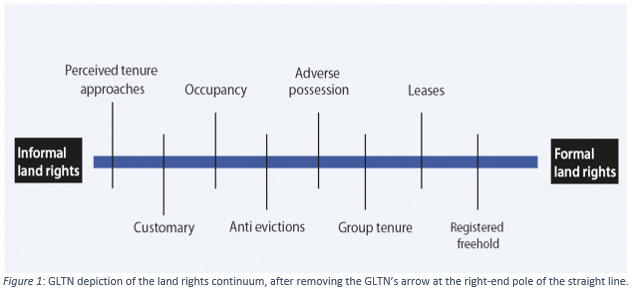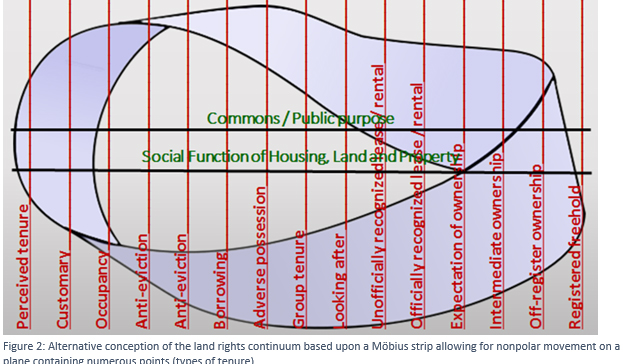Continuum of tenure
The continuum of tenure is an approach to recognizing rights of possession that has developed as a system of thought in which diverse practices of housing and land access and use patterns coexist. The recognition of this plurality allows a diversity of tenure situations, ranging from the most-informal types of possession and use to full ownership. The continuum developed by the Global Land Tool Network (GLTN), which was adopted at the 2011 UN-Habitat Governing Council resolution by Member States, is now widely accepted by the development community and UN member states.
The land-rights continuum concept recognizes that:
- Tenure can assume a variety of forms;
- The various rights do not actually lie on a single line, but may overlap with one another;
- Rights at the most-formal end of the continuum should not be seen as the preferred or ultimate form of land rights;
- The points on the continuum are each one of several appropriate and legitimate forms that may coincide; the most appropriate form depends on the particular time and context.

However, the linear graphic and concepts presented above pose some contradictions. The recognition that the various rights do not lie on a straight line would suggest a form other than a straight line to represent any position, process or movement along the spectrum. The linear representation also does not convey the potential combinations or hybrid cases. The suggested “progress” along the line, from left to right (in European languages) implies movement toward a culmination point or, at least, a process toward formality.
Given the hazards arising from that graphic, HIC-HLRN has developed an alternative conception. In order to convey the sense of a true continuum and the potential movement along it, a Möbius strip is used. Facing the further dilemma of representing tenure types not yet depicted on the linear pattern, the actual tenure status of public land and property, or public-purpose acquisition of land and property, lie outside the course of other land and property claimed by people. Akin to the common use and benefit of land and property, the further recognition of its social and environmental functions is as a feature of all forms of land and property at all times. Therefore, the resulting graphic depicts that constant as penetrating all other types and points on the continuum. In that case, both the commons/public-purpose and the social function of land and property form aspects that are consistent with, and, hence, axes running through land and property of all tenure types belonging or potentially subject to each status and point along the continuum.

|